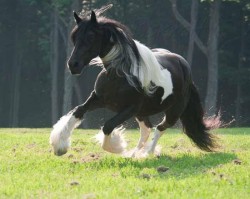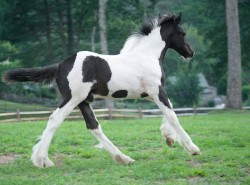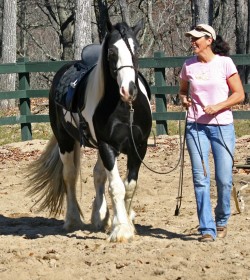
Training Tip #4 with Felicia Britt
- Home
- News & Events
- Gypsy Vanner Blog
- Training Tip #4 with Felicia Britt
You've found your confidence and are beginning to believe your goals can be realized. You've mustered your courage and conquered some respect-earning territory. You've honed your techniques on the slippery rock of self-control...and now the fun begins!
Of all the qualities I look for in a horse, INTEREST is always at the top of my list. No matter how beautiful or structurally correct a horse may be, if his attitude is bitter, dull, or unapproachable, it is like a gold ring in a pig's snout. Cultivating your horse's natural curiosity is the most versatile tool in your toolbox. Let's start with the kitchen sink.
B.R.A.I.N.
UNDERSTANDING BEGINS ON THE GROUND
 I – is for INTEREST Foals are so curious. They come to you readily and investigate everything. Unfortunately, often by the time she is a yearling, she has been convinced that halters mean work, work means circles, circles mean boredom, so she dislikes halters. Or, more accurately, people with halters. Her curiosity has been squelched and her interest diluted to a passing glance. Whether a weanling colt and a horse you've had for years, maintaining her interest is where every teachable moment resides. When I start a horse, I want to expose her to everything I can think of INCLUDING the kitchen sink! Think of her mind as one of those tiny rubber bands you put in a mane. You want to stretch her tolerance, little by little, until her brain is so flexible it like a hundred foot long bungie cord! As I describe some suggestions keep in mind that the benefits are two fold. We are not only using a variety situations to pique interest, but at the same time introducing some serious desensitizing exercises for a much braver horse later. If done correctly, your horse will look forward to your time together with anticipation and wonder. Your training sessions can't always be fun and games, but they can certainly begin and end with them!
I – is for INTEREST Foals are so curious. They come to you readily and investigate everything. Unfortunately, often by the time she is a yearling, she has been convinced that halters mean work, work means circles, circles mean boredom, so she dislikes halters. Or, more accurately, people with halters. Her curiosity has been squelched and her interest diluted to a passing glance. Whether a weanling colt and a horse you've had for years, maintaining her interest is where every teachable moment resides. When I start a horse, I want to expose her to everything I can think of INCLUDING the kitchen sink! Think of her mind as one of those tiny rubber bands you put in a mane. You want to stretch her tolerance, little by little, until her brain is so flexible it like a hundred foot long bungie cord! As I describe some suggestions keep in mind that the benefits are two fold. We are not only using a variety situations to pique interest, but at the same time introducing some serious desensitizing exercises for a much braver horse later. If done correctly, your horse will look forward to your time together with anticipation and wonder. Your training sessions can't always be fun and games, but they can certainly begin and end with them!
Start by placing an object in an arena or pasture. I like to hang something on the fence where I usually work. Start with just one item, then before long you will have a half dozen. Lead your horse to that area and go through your normal routine, completely ignoring the object. Observing him closely will tell you the proper distance to stay away from the item, to keep anxiety to a minimum. Your ultimate goal here is to teach him self-control. His instincts tell him to run, but your body language tells him it is okay. It is critical that you appear completely unaffected by the object. He is going to scrutinize your tone of voice, posture and expression for even the slightest indication that it is time to RUN. If he is anxious and you stop your routine and pet him, you are rewarding his fear, as well as confirming it. If the object is more distracting than interesting, move farther away, but continue your routine. When everything else stays the same, especially you, he begins to go through his mental list and ask himself questions. Your self-control teaches him self-control. Your calm demeanor conveys to him that the object is a non-issue. Stopping and staring at it simply doesn't work for me. I think he just wonders WHEN it is going to eat us both.
For horses that are more sensitive to change, I usually do not do this next step until she has experienced several different objects hanging on the fence during multiple sessions. By then, she is really beginning to wonder about all those 'things' hanging around. Then, at the end of a lesson, I lead her over to the object, let her touch it with her nose once, then lead her away. Often, you will hear a big sigh...question answered. And boy! Did you get a lot of respect from her as you displayed so much courage in the midst of such danger. (A scary stuffed teddy bear sitting on top of the fence post). When you begin to add various objects to this game, it becomes some major league desensitizing. But, the great part is the day she walks into the arena LOOKING for objects to investigate. I love to witness this transition and delight in ignoring the elephant in the room until she is dying to go exploring. At this point, I begin to say the word “touch”, just before her nose makes contact with the object. Remember to walk away immediately after a single touch. Before long, you are actually SENDING her to touch things. This 'touch' cue transfers beautifully to the trail. Whenever one of my trainees sees something 'spooky', whether we are leading or riding, I give her some slack and say 'touch'...then, fear becomes curiosity because she knows the game is not scary, so this must not be either.
There is a beautiful, black mare I have in training named Love. She came to me as a 6 year old retired show horse who had never been ridden out of the show ring. Whether a youngster or a finished show horse, I always put my first 30 rides on one in the woods. I feel nothing solidifies the trust bond better, than a horse in unfamiliar surroundings having to fully rely on her handler. I feel that exploring the forest instills, or in this case, rekindles a horse's curiosity and sparks her courage.This mare had never been on a trail in her life and was simply afraid of everything....including butterflies and grasshoppers!
 As time passed, Love progressed nicely and fell completely in love with the 'touch' game. She would come into the arena(which she formerly hated)like a bull looking for a target. She was so fun to watch as she grew braver and braver. In the woods, she had to 'touch' everything. It would take us an hour to go 200 yards, but I let her. In my mind, she was erasing years of stress...it was all about the process. I knew the product would come.
As time passed, Love progressed nicely and fell completely in love with the 'touch' game. She would come into the arena(which she formerly hated)like a bull looking for a target. She was so fun to watch as she grew braver and braver. In the woods, she had to 'touch' everything. It would take us an hour to go 200 yards, but I let her. In my mind, she was erasing years of stress...it was all about the process. I knew the product would come.
The best day of all was when Love's owner, MJ, and I went for a trail ride on an adjacent cattle ranch. MJ was on her mare and entered the pasture gate a few yards in front of me. I had instructed her on the intricacies of the 'touch' technique and she was confident and determined to impress. Love immediately became curious about the brown blobs that littered the ground. As I observed from behind, MJ dutifully approached each one and said 'touch' and moved on. After about the twentieth pile, I thought I was going to fall off my horse laughing as I wondered if she would 'touch' all 12,572 cow pies. She didn't, but my ribs were sore for a week!
Since every unfamiliar scenario cannot possibly be reproduced, the goal is to give your horse the tools to deal with situations as they arise. He will learn self control and so must you. If you are anxious and tense, expecting a train wreck...you usually get one. A calm demeanor shows you have taken on a confident leadership role. If your horse has passed this stage of his training, it is still critically important that your time with him stay interesting. Resist the temptation of allowing his conditioning to become mindless lungeing and trail rides becoming dull and unchallenging.
As we have discussed, skills are taught layer upon layer. Decide what you are going to work on that day and what new elements you are going to introduce. I like to follow the same pattern most of the time. 1) Warm Up His Brain(review) 2)Warm Up His Body(conditioning) 3)Today's Lesson(new element) 4)Build Confidence(review) 5) Relax(cool down & flex) This pattern works for me with horses at all levels of training. Even if your horse is under saddle, begin on the ground. Go through everything your horse has learned recently. Mix it up. Do several skills in a row, increasing the difficultly and speed as his brain comes alive. I like to do what I call circuit training. Just like in the gym, varying the skills, conditions more than just muscle...the brain has to concentrate to keep up. For example: I lead the horse at walk, stop, back 4 steps, stop, wait, pivot 90 degrees, back 4, trot off, stop, wait....stand...pivot 180 degrees, switch sides and repeat entire circuit, leading from the right side of the horse. Then, send the horse out on the circle, walk relaxed , pick up trot, trot 2 circles, walk 2 circles, stop. Pivot 180 degrees on circle and repeat. Then trot on off side to obstacle course set up in the yard and practice trail elements. Trot back to arena and go through entire 'set' again. This time adding a canter, or side pass, or pivot on the forehand. Reverse & repeat on the other side. Whatever your horse has learned, include it in the circuit. Then, if your under saddle, mount up, and do the entire circuit again. Be clear with your communication, keeping your posture, voice and expression balanced. Begin to minimize your cues, while picking up tempo. In my experience, it is great way to keep him interested and really using his mind. Make it hard, purposefully. HAVE FUN!
 Obviously, this is one of my favorite areas of training. It is challenging for the horse and handler, both physically and mentally. Best of all, the workout you develop for him is limited only to your imagination and to be sure, the rewards are great. He will begin to look at your time together with interest and wonder. It is a place where he doesn't just yield to your authority, but CHOOSES to be in your company. That is the heart of a horse....his will.
Obviously, this is one of my favorite areas of training. It is challenging for the horse and handler, both physically and mentally. Best of all, the workout you develop for him is limited only to your imagination and to be sure, the rewards are great. He will begin to look at your time together with interest and wonder. It is a place where he doesn't just yield to your authority, but CHOOSES to be in your company. That is the heart of a horse....his will.
Every moment you spend with your horse, you are training him. Make the most of it. Believe in yourself, so he will too. Control the territory, so he will follow. Communicate clearly, so he will understand. Kindle his interest, so he will let you in......and....finally...
Next Time N – NEVER NEGOTIATE
Feel free to post your questions or comments here. Remember! There are NO dumb questions. We will be at the Spring Feathered Classic April 16-17 in Shelbyville, TN. Drop by our stalls and say "hello"!


Comments
Lois Shuart | posted April 09, 2010
I love the article. I do find it hard to view on screen with the dark background. It would be nice to have a print mechanism so I can read at a more convenient time in larger print.
Hi Lois! I sent your comment to my web designers to see if there is something they can add for that. In the meantime I also sent you a copy in word. Thanks!
Robin
ken studdard | posted April 09, 2010
thanks for taking your time to share these stories
Robin | posted April 09, 2010
You are more than welcome. Don’t forget if you have any questions we will be happy to help.
Margery Wentworth | posted April 09, 2010
I was just up to the highlands last week and hopefully the next time I’ll get to see Robin. I actually met Hulio, from Palettis who was due to have dinner the following night. We saw properties and were there looking at Meg’s stable which we are considering for an august/sept trip with my 5 year old Norwegian Fjord.
I thank you for sending your training tips. Maybe if I’m up I could have you work with us. LOKI, my fjord is very stuborn and needs lots of interest and motivation; he’s a LBI if you follow parelli which we are practicing natural horsemanship and my trainer is working with me weekly. We do have a problem at times going forward and keeping forward with a squeeze, cluck and spank. He does beautifuly on the ground loves games; when he is stuborn and just wants to stop and go back to his pasture he often will just begin backing up and I really don’t want to use force but repeating the squeeze, cluck and spank isn’t working. Maybe you have some ideas. Interesting when I go and get a frisbee and trow it he immediately will almost engage in a trot to get it to give it to me. He’s very food motivated and I’ve trained him on many things on the ground; it’s just taking time to move it under saddle. He was a trail horse out of South Dakota and his temperment is sweet and he’s very willing. Any ideas of getting him to move forward would be most appreciated. Thank you again for your assistance. Sincerely, Margery
david crais | posted April 11, 2010
I am glade you haven’t kept this knowledge to youself.Thank you for sharing your hard earned exprtise.